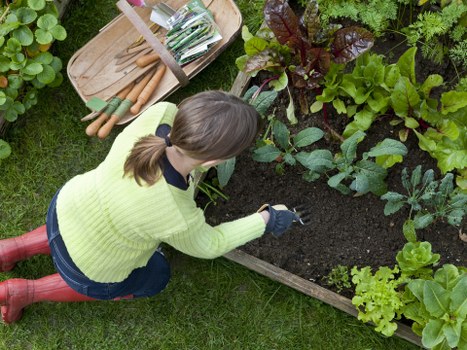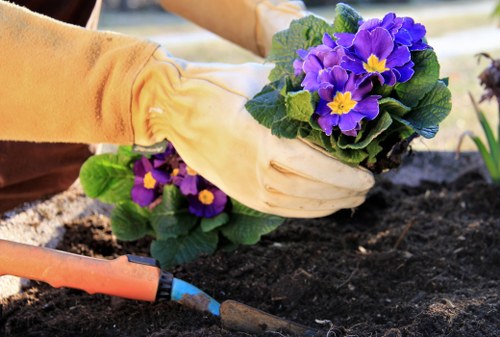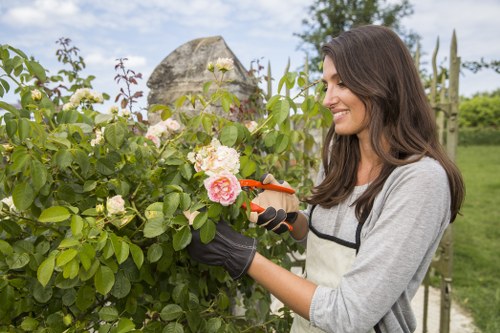Hedge Trimming in Brockley
Understanding the Importance of Hedge Trimming

Hedge trimming is a crucial aspect of garden maintenance that enhances both the aesthetic appeal and the health of your outdoor spaces. In Brockley, where gardens are a cherished part of residential life, maintaining well-trimmed hedges can significantly boost the overall look of your property.
Regular trimming helps in controlling the size and shape of your hedges, preventing them from becoming overgrown and unmanageable. It also encourages dense growth, ensuring that your hedges provide adequate privacy and act as effective windbreaks or sound barriers.
Moreover, hedge trimming plays a vital role in the health of the plants. By removing dead or diseased branches, you reduce the risk of pests and infections spreading, thereby promoting a healthier garden environment.
Benefits of Hedge Trimming

One of the primary benefits of hedge trimming in Brockley is the enhanced curb appeal it provides. A well-maintained hedge can transform the appearance of your property, making it more attractive to visitors and potential buyers.
Additionally, regular trimming ensures that your hedges remain in good health. By cutting back overgrown branches, you allow more light and air to penetrate the foliage, which is essential for robust plant growth.
Another advantage is the prevention of unwanted pests. Trimmed hedges are less likely to harbor insects and other pests that can damage your plants and affect the overall ecosystem of your garden.
When to Trim Your Hedges

Timing is crucial when it comes to hedge trimming. In Brockley, the ideal times for trimming are typically in late spring and early autumn. These seasons provide the best conditions for hedges to recover and grow healthily.
Trimming during the growing season encourages new shoots and a fuller, denser hedge. Avoiding trimming during the peak of summer or the depths of winter helps prevent stress on the plants, ensuring they remain vigorous and healthy.
It's also important to consider the type of hedge you have. Different species have varying growth patterns and may require specific trimming schedules to achieve the best results.
Types of Hedges and Their Trimming Needs

There are several types of hedges commonly found in Brockley gardens, each with its own trimming requirements. Understanding these needs is essential for effective maintenance.
- Boxwood: Known for their dense foliage, boxwoods require regular trimming to maintain their shape and prevent overgrowth.
- Yew: Yews are hardy and can tolerate heavy trimming, making them a popular choice for formal hedges.
- Privet: Fast-growing and versatile, privets are ideal for creating thick, privacy screens but need frequent maintenance to stay in check.
Each type of hedge responds differently to trimming, so it's important to tailor your approach based on the specific characteristics of the plant.
Essential Tools for Hedge Trimming

Having the right tools is fundamental to achieving clean and effective hedge trims. Here are some essential tools you'll need:
- Pruning Shears: Ideal for precise cuts on smaller branches.
- Hedge Trimmers: Electric or gas-powered trimmers are perfect for handling larger sections of hedge quickly.
- Loppers: Useful for cutting thicker branches that pruning shears can't handle.
- Gloves and Safety Goggles: Protect your hands and eyes while trimming.
Investing in quality tools not only makes the trimming process easier but also ensures that your hedges receive clean cuts, promoting healthier growth.
Techniques for Effective Hedge Trimming
Proper trimming techniques are essential for maintaining the health and appearance of your hedges. Here are some tips to help you achieve the best results:
- Plan Your Shape: Decide on the desired shape of your hedge before you start trimming. Common shapes include straight, curved, or tiered.
- Trim in Sections: Work on small sections at a time to ensure even trimming and to avoid missing any areas.
- Maintain Even Height: Use a string or a long level to keep the height consistent across the entire hedge.
- Clean Up Debris: Remove all trimmed branches and leaves to prevent disease and pests from taking hold.
By following these techniques, you can achieve a professional-looking trim that enhances the beauty of your garden.
Choosing a Hedge Trimming Service in Brockley
Selecting the right hedge trimming service can make a significant difference in the upkeep of your garden. Here are some factors to consider when making your choice:
- Experience: Look for a service with a proven track record and plenty of experience in hedge trimming.
- Reputation: Check reviews and testimonials to gauge the quality of their work.
- Insurance: Ensure the service is insured to protect against any accidental damage during the trimming process.
- Pricing: Compare quotes from different providers to find a service that offers good value for money.
Choosing a reputable and reliable hedge trimming service in Brockley ensures that your hedges are maintained to the highest standard.
DIY vs. Professional Hedge Trimming
Deciding between DIY hedge trimming and hiring a professional service depends on various factors, including your budget, time, and the complexity of the task.
DIY Trimming: While trimming hedges yourself can save money, it requires time, the right tools, and a certain level of expertise. It's suitable for small gardens or those who enjoy gardening as a hobby.
Professional Services: Hiring professionals ensures that the job is done efficiently and correctly. Professionals have the necessary tools and knowledge to handle different types of hedges and can achieve a flawless finish.
Cost Considerations for Hedge Trimming
The cost of hedge trimming in Brockley varies based on factors such as the size of the hedge, the type of plants, and the complexity of the trimming required.
- Size of the Hedge: Larger hedges require more time and effort, increasing the overall cost.
- Type of Hedge: Some plants are more difficult to trim and may require specialized tools or techniques.
- Frequency of Maintenance: Regular maintenance can help manage costs by preventing the need for extensive trimming sessions.
It's important to get multiple quotes and understand what is included in each service to ensure you're getting the best value for your investment.
Maintaining Your Hedges Post-Trimming

After trimming, proper maintenance is essential to ensure the continued health and beauty of your hedges. Here are some key maintenance tips:
- Watering: Ensure your hedges receive adequate water, especially during dry periods, to promote healthy growth.
- Fertilizing: Apply a balanced fertilizer to provide essential nutrients that support vigorous growth.
- Pest Control: Monitor your hedges for signs of pests or diseases and take appropriate measures to address any issues promptly.
Regular maintenance not only keeps your hedges looking their best but also extends their lifespan, ensuring long-term enjoyment of your garden.
Environmental Benefits of Trimming Hedges
Beyond aesthetics and plant health, hedge trimming offers several environmental benefits. Well-maintained hedges contribute to a healthier ecosystem in your garden.
- Biodiversity: Hedges provide habitats for various birds, insects, and small mammals, enhancing biodiversity.
- Air Quality: Dense hedges act as natural air filters, trapping dust and pollutants and releasing oxygen.
- Soil Protection: Hedges help prevent soil erosion by stabilizing the ground with their root systems.
By regularly trimming your hedges, you ensure they continue to provide these environmental benefits effectively.
Choosing the Right Time of Year for Hedge Trimming
Timing your hedge trimming correctly can significantly impact the results. In Brockley, the best times to trim hedges are during the late spring and early autumn months.
Trimming in late spring allows plants to recover quickly and produce new growth during the warmer months. Early autumn trimming prepares the hedges for winter, reducing the risk of damage from frost and heavy snow.
Avoid trimming during the peak of summer or the depths of winter, as extreme temperatures can stress the plants and hinder their ability to recover.
Safety Tips for Hedge Trimming
Hedge trimming can be hazardous if not done properly. Here are some safety tips to keep in mind:
- Wear Protective Gear: Always wear gloves, safety goggles, and sturdy footwear to protect yourself from injuries.
- Use the Right Tools: Ensure that your trimming tools are in good condition and appropriate for the job.
- Be Mindful of Your Surroundings: Watch out for power lines, pets, and children when trimming large or tall hedges.
- Take Breaks: Avoid overexertion by taking regular breaks during long trimming sessions.
By following these safety precautions, you can minimize the risk of accidents and ensure a safe trimming experience.
Enhancing Hedge Health Through Proper Trimming
Proper trimming not only improves the appearance of your hedges but also contributes to their overall health. Here are some ways trimming enhances hedge health:
- Air Circulation: Thinning out dense foliage allows better air circulation, reducing the likelihood of fungal infections.
- Sunlight Exposure: Adequate sunlight encourages photosynthesis, which is vital for plant growth and vitality.
- Removal of Damaged Branches: Cutting away dead or diseased branches prevents the spread of diseases and pests.
Maintaining healthy hedges through proper trimming ensures they remain robust and are less susceptible to environmental stresses.
Seasonal Hedge Trimming Tips
Different seasons require different trimming approaches to maintain hedge health and appearance. Here are some seasonal tips:
- Spring: Focus on promoting new growth by lightly trimming to encourage bushiness.
- Summer: Perform light shaping and control to prevent hedges from becoming too dense.
- Autumn: Conduct a more thorough trim to prepare hedges for winter, removing any weak or damaged branches.
- Winter: Avoid heavy trimming during cold months to prevent damaging the plants.
Adapting your trimming strategy to the seasons ensures that your hedges remain healthy and visually appealing year-round.
Advanced Hedge Trimming Techniques
For those looking to achieve professional-grade trims, advanced techniques can make a significant difference. Here are some methods to consider:
- Topiary: This artistic form of trimming involves shaping hedges into decorative forms and figures, adding a unique touch to your garden.
- Scalping: Lightly trimming the outer branches to encourage denser inner growth without altering the overall shape.
- Selective Pruning: Choosing specific branches to remove improves the structure and health of the hedge without excessive trimming.
Implementing these advanced techniques can elevate the appearance of your hedges and contribute to a more sophisticated garden design.
Common Mistakes to Avoid in Hedge Trimming
Avoiding common trimming mistakes is essential for maintaining healthy and attractive hedges. Here are some pitfalls to watch out for:
- Over-Trimming: Cutting back too much can stress the plants and inhibit new growth.
- Ignoring Plant Type: Different hedges have specific trimming needs; using the wrong technique can damage the plant.
- Poor Tool Maintenance: Dull or dirty tools can make uneven cuts, increasing the risk of disease.
- Incorrect Timing: Trimming at the wrong time of year can disrupt the natural growth cycle of the hedges.
Being mindful of these mistakes ensures that your hedge trimming efforts yield the best possible results.
Sustainable Practices in Hedge Trimming
Adopting sustainable practices in hedge trimming not only benefits your garden but also the environment. Here are some eco-friendly approaches:
- Using Electric Tools: Opt for electric hedge trimmers over gas-powered ones to reduce carbon emissions.
- Composting Clippings: Instead of discarding trimmed branches, compost them to create nutrient-rich soil for your garden.
- Water Conservation: Trim hedges early in the morning or late in the evening to minimize water loss during watering.
Incorporating these sustainable practices promotes a healthier garden ecosystem and reduces your environmental footprint.
Choosing the Right Hedge Trimming Schedule
Establishing a regular trimming schedule is key to maintaining healthy and attractive hedges in Brockley. Here are some guidelines:
- Annual Trimming: Perform a major trim once a year, preferably in late spring or early autumn.
- Biannual Maintenance: For fast-growing hedges, consider trimming twice a year to keep them in check.
- Quarterly Checks: Conduct minor adjustments and clean-ups every few months to maintain the shape and health of your hedges.
Sticking to a consistent schedule ensures that your hedges remain well-maintained and free from overgrowth issues.
Impact of Climate on Hedge Trimming
The climate in Brockley can influence the timing and method of hedge trimming. Understanding local weather patterns helps in planning effective trimming sessions.
In temperate climates, hedges can be trimmed almost year-round, with specific attention to avoiding extreme temperatures. However, in regions with harsher winters, it's important to protect hedges from frost damage by limiting trimming during cold spells.
Additionally, rainy seasons can make trimming more challenging and increase the risk of plant diseases. Planning your trimming activities during dry, mild weather promotes better healing and growth.
Enhancing Garden Design with Trimmed Hedges
Well-trimmed hedges are not just functional; they also play a significant role in garden design. They can define spaces, create visual interest, and complement other elements in your garden.
- Boundary Definition: Hedges can clearly delineate different areas of your garden, such as separating a vegetable patch from a flower bed.
- Screens and Privacy: Tall hedges provide privacy from neighbors and create secluded areas within your garden.
- Visual Focal Points: Artistic trimming techniques can turn hedges into stunning focal points that draw attention and add character to your garden.
By strategically trimming your hedges, you can enhance the overall design and functionality of your outdoor space.
Professional Hedge Trimming Services in Brockley
For those who prefer to leave hedge trimming to the experts, professional services in Brockley offer comprehensive solutions tailored to your garden's needs.
Professional hedge trimmers have the expertise and equipment to handle a variety of hedge types and sizes efficiently. They provide precise cuts that promote healthier growth and a polished appearance.
Hiring a professional service also saves you time and effort, allowing you to focus on other aspects of garden care or enjoy your outdoor space without the hassle of heavy trimming tasks.
Conclusion: Keeping Your Hedges Pristine in Brockley
Maintaining well-trimmed hedges is essential for a beautiful and healthy garden in Brockley. Whether you choose to trim your hedges yourself or hire a professional service, understanding the importance, techniques, and best practices ensures that your hedges remain a stunning feature of your outdoor space.
Regular hedge trimming not only enhances the visual appeal of your property but also contributes to the overall health and longevity of your plants. By following the tips and guidelines outlined in this article, you can achieve pristine hedges that you can be proud of.
Contact us today to book your hedge trimming service and give your garden the care it deserves!